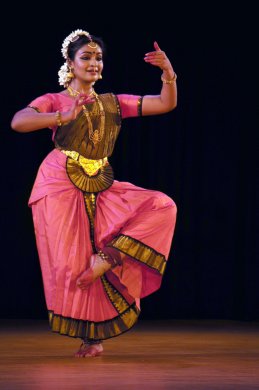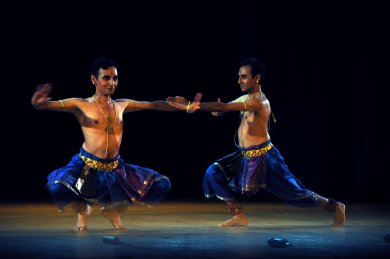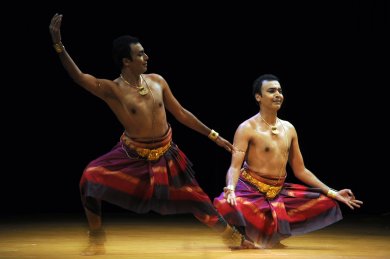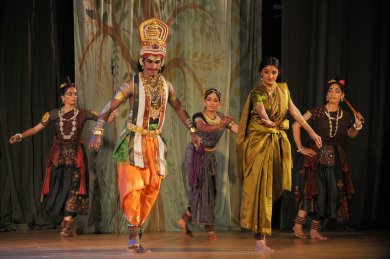
|   |

|   |
The Madras Music Academy Dance Festival - Day 2 - Veejay Sai e-mail: vs.veejaysai@gmail.com Photos: Thanthoni January 8, 2017 Slow sarasam displaces good sarcasm The morning of the second day began with a performance by Jai Quehaeni Reddy, a student of Guru Chitra Visweswaran. Jai has a pleasant demeanor and a great stage presence.  After an invocation to Ganesha in the form of an Oothukadu Venkata Kavi’s composition “Pranavakaaram” set to Aarabhi ragam and adi talam, Jai took time to warm up. In the charanam “Shiva gana sura gana mahataananda natanam” that describes Ganesha’s dance, she displayed the various instruments that played for the lord as he danced. Murali Parthasarathy’s melodious singing was to stay constant for a large part of the rest of the performance. Jai continued her performance with a pada varnam “Sakhiye nee solladee” with music composed by Madurai T Sethuraman. While she executed each of the jathis well, the problem was the footwork. All of it was hidden behind the unusually long saree costume she wore. It went all the way down below her ankles covering everything. Neither were simple elements like aramandi visible, nor was any of the meager footwork she displayed. In the story of a nayika who tells her friend to go convince lord Krishna that she has been waiting for him, this varnam by Geetha Priyan is not a regular one. Despite the newness of the varnam being presented and the clean finish of her theermanams, one found a lack of energy in Jai’s dance. The first part of the varnam and the second half seemed to be in the same tempo. Where was the vigour of the Vazhuvoor school of nritta? Only few seasons ago Jai danced with far more energy than she did now. In the second half of the varnam where the nayika says ‘Jaalam seyya taguma’, Jai’s energy didn’t get better. The nritta elements were almost absent, which makes you think if all that is sung can be danced? This particular composition, while it sounds melodious when rendered in music lacked the energy to flex itself for a full length varnam. This monotonous kaala pramanam stayed on in the next piece Jai presented. The famous padam ‘Netrandhi nerathile’ by Subbaramaiyer set to Huseni ragam and rupaka talam followed. The nayika here is suspicious of Muruga who she saw having a quick dalliance with another woman on the banks of the river. She confronts him with her subtle sarcasm and anger. The nayika here is a khandita who is hurt about what her lover has done to her. But in Jai’s dance we saw the opposite. She seemed to be grinning from ear to ear even as she expressed her suspicion. This quality of ‘Sarasam’ was unasked for and disrupted the mood of the padam, totally changing the sthayi bhaavam of the nayika here. The performance ended with a famous Poochi Srinivasa Iyengar thillana in ragam Paras. Once again, the lack of good nritta was visible. Jai is a good dancer. She has performed excellently in the past, so this time around, expectations were higher. Hopefully she will realize the Vazhuvoor bani she represents and bounce back with her usual energy. K P Nandini’s violin and Tyagarajan Ramani’s flute were the best part of the orchestra. They enhanced the mood of ragams like Kalyani and Huseni. Guru Chitra Visweswaran conducted the dance recital. The bright blue Bangalore brigade For a long time, everyone has been saying the Bharatanatyam capital is slowly shifting to the garden city of Bangalore. That Bangalore has more institutions, more gurus and has produced more number of soloists is contestable. In the male dancer world, Bangalore certainly stands tall. Among those who have made a name and marked their presence strongly from Bangalore is Praveen Kumar. A student of late Guru Narmada and now training with veteran Guru C.V. Chandrasekhar, Praveen is one of Bangalore’s senior most Bharatanatyam soloists who has made an international name for himself.  Performing in the sub-senior slot in the morning, Praveen was a breath of fresh air in the morning show. Opening with a Jatiswaram composed by Kameshwaran in ragam Abhogi and adi talam, Praveen was a bundle of energy. D.S. Srivatsa’s melodious vocals were to enhance the show as it went along. Taking excerpts from Bilvamangala’s Srikrishna Karnamritam, Praveen presented it in the form of a varnam. With music tuned by Jhanavi Jayaprakash, and set to ragam Hindolam, the excerpts began with describing Krishna as the butter thief. “Vadane navaneeta gandha” saw the various childhood pranks of Krishna. Describing the beauty of Krishna, his leelas and his games under the Kadamba tree in the rest of the composition, it was a delight to watch Praveen performing. Some of the choreography seemed a little abrupt. We suddenly see Krishna playing with a ball, the ball falling into the waters and Krishna having vanquished Kaliya all in a back-to-back sequence. Some of this choreography needs reworking. Praveen followed this with “Theertha Karayinile,” a composition of Subramanya Bharatiyar. But what was striking was the lesser-known javali of Mysore Vasudevacharya. In “Prematho naatho maatladava” set to ragam Kanada and adi talam, the hero, most often Krishna is trying to please the khandita nayika and convince her to speak to him. “Priye naa pai kopama,” the hero asks displaying all the various moods of her anger with a tinge of sarcasm. And when she doesn’t heed to his words, he simply finds another woman to get on with. The thillana by Dwaraki Krishnaswamy set to ragam Valaji dedicated to devi didn’t seem to fit in place of the mood of Krishna that we were enthralled with all along. Lingaraju is one of the rare mridangam vidwans who observes his dancers and plays instinctively. His sense of precision matched Praveen’s performance all along. Prasanna Kumar’s nattuvangam, Mahesh Swamy’s flute, Mandya Nagaraj’s violin accompaniment only enhanced the show further. The entire orchestra and the dancer were dressed in blue. With great subtlety and masterful grasp of technique, Praveen is easily Bangalore’s finest Bharatanatyam dancers. He and his blue brigade of musicians from Bangalore were the first to get a standing ovation at the festival. Vibrant Arekar – a star among male dancers There was a great deal of excitement and confusion before the evening’s performance of Vaibhav Arekar. For one, he is not a known local name in Chennai. And he is not a Tamilian or a south Indian either. So several rasikas were caught amidst curious conversations about who and what he was. This was important to notice for couple of reasons. Though there have been many male dancers over the last few decades, celebrated star soloists have been far and few. Those who can equal their female counterparts haven’t come around in a long while. So when a male dancer was programmed in the prime slot, barely a day into the Academy’s festival, rasikas were curious to find out who and what. This was justified with the performance Vaibhav gave.  Vaibhav began his performance with an ode to Ganesha. To establish himself on the stage right in the beginning without using the support of any musical instruments but in complete silence was a visually stunning element. Vaibhav presented a rare varnam “Daani korikenu” set to ragam Vasanta and misra jhampa talam composed by Ramanathapuram Srinivasa Iyengar. Describing lord Vishnu as the lotus-eyed one, Tamarasaksha, the nayika is smitten by his beauty. She pines for oneness with the lord, both at a physical and at a spiritual level. While the content of this varnam fits with the scheme of most of the others that express nayika bhavam, the way Vaibhav rendered it was extraordinary. His involvement with the mood and the theme of the varnam, his emotional depth and experience of rasa was visible to all in the audience. After this wonderful varnam his choice to skip the padam “Ososi” as listed was good. He performed abhinaya to a traditional subhashita that explores the hasya rasa. This has been performed earlier but is always a delight to watch as very few dancers have managed to successfully convey the essence of the rasa without making it a mockery. Vaibhav’s mastery over setting to tune and dancing Marathi Abhangs is as good as his Bharatanatyam. In the last couple of years he has been working extensively to set to tune and dance the works of several saints of Maharashtra in the Vaarkari Sampradaya. Tukaram, Eknath, Namdeo and many others’ writings have gained a fresh lease of life on the classical dance stage. In ‘Ek Aarohana Nandi’, a composition of saint Eknath Maharaj, we saw the praises of both Hari and Hara and how they are equal. Sushant Jadhav is one of the best light designers we have in the Bharatanatyam scene. His art needs to be seen more often in Chennai and in the dance circles. Vaibhav’s performance had the audience eating out of his hands. A thunderous applause and a standing ovation! Vaibhav, a non-south Indian male soloist is a great example of a successful dancer who fought odds to reach where he is. There is a misconception among a lot of others that if you aren’t a south Indian or a female, the opportunities to become a successful dancer are less. While that might only be partially true, it is not impossible to become a successful soloist. One just needs to put in sufficient hard work, stay focused and be completely consumed by their passion to dance. Vaibhav’s performance in the star slot of this prestigious festival should give strength to many more male dancers who want to pursue a full time career in classical dance. Waiting for freshness After the high of Vaibhav’s brilliant performance, we were got back to reality by the next presentation. Kalakshetra presented the ‘Choodamani Pradanam’ episode from their once iconic Ramayana. With exceptional music by the legendary Mysore Vasudevacharya and choreographed by Rukmini Devi Arundale, this is the magnum-opus work of the Kalakshetra repertory ever since it was formed way back in the 1940s. But that might be the larger part of the happy news about this production.  The story of the episode is very well known and I don’t have to go through it all over again. The episode begins with Rama and Lakshmana in search of Sita who has been kidnapped by Ravana earlier. It ends with Hanuman returning to Rama with Sita’s Choodamani from Lanka. The hero of this episode is Hanuman. The entire focus shifts to depicting the power of Hanuman and his Rama bhakti. For one, the entire group was far better than what they usually are. However some of the characters were a serious miscast. While Rama has a very minor role to play in this episode, casting Girish Madhu as Rama was as misplaced as Sreedevi who played Sita. The rest of the other characters in the episode, including Sugreeva, Vali, Nala and Neela seemed totally under-rehearsed. The star role of the episode Hanuman was enacted by Hari Padman. He was the only saving grace of this production. He reminded one of the older productions where Prof Balagopal played the same role and excelled in it! It might have been the presence of Tamil superstar Rajinikanth in the first row of the audience, Hanuman’s excitement seemed more pronounced. It also felt nice to know that such big film stars take solace in classical arts when they have some free time to spare. A phenomenon that doesn’t occur in any other city in a country, whose population is obsessed by mainstream cinema. What Kalakshetra needs to do is desperately invite a consultant dramaturg who will bring in a lease of freshness into their production. That Rukmini Devi created it is fine and touching any of this wouldn’t amount to a cultural crime. In fact, had she been around, she would have herself revisited a lot of the production values, props, costumes and backdrops to suit today’s needs. Hopefully Kalakshetra’s administrators will take a note of this and refresh this great production. With melodious singing by Hariprasad, Srividya Vishwanath’s veena and other accompanying artistes of the orchestra, they recreated the glory of Vasudevacharya’s immortal music. All in all Kalakshetra’s presentation was not the best of what they are capable of doing. Veejay Sai is a writer, editor and culture critic. |